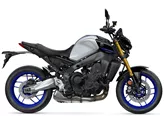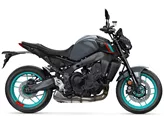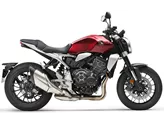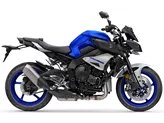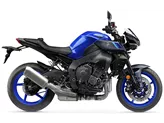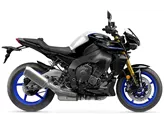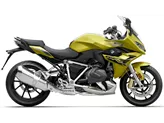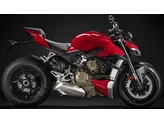Yamaha MT-09 2016 vs. Yamaha MT-10 2017

Yamaha MT-09 2016

Yamaha MT-10 2017
Vue d’ensemble - Yamaha MT-09 2016 vs Yamaha MT-10 2017
The Yamaha MT-09 2016 and the Yamaha MT-10 2017 are both naked bikes from Yamaha, but they have some key differences in terms of their technical specifications and strengths.
Starting with the Yamaha MT-09 2016, it is equipped with a three-cylinder engine that produces 115 horsepower and 87.5 Nm of torque. The engine has a displacement of 847cc and is paired with a telescopic fork front suspension. The frame is made of aluminum and has a twin tube design. The front brakes are double disk type and the front tire has a width of 120mm and a diameter of 17 inches. The rear tire is 180mm wide and also has a diameter of 17 inches. The wheelbase is 1440mm and the seat height is 815mm. The bike weighs 191kg with ABS and has a fuel tank capacity of 14 liters.
The strengths of the Yamaha MT-09 2016 include its powerful three-cylinder engine, which provides a thrilling riding experience. It also has three power modes, allowing the rider to adjust the performance to their preference. The chassis is fully adjustable, allowing for fine-tuning of the bike's handling. The quickshifter is a standard feature, making gear changes smooth and effortless. The sporty upright seating position offers comfort and control. The brakes are effective and provide good stopping power. The aggressive looks of the bike are also a plus, giving it a distinctive and eye-catching appearance. Finally, the traction control system helps to keep the bike stable and in control.

Yamaha MT-09 2016
However, the Yamaha MT-09 2016 does have a few weaknesses. The saddle can be a little too hard for long tours, potentially causing discomfort for the rider. Additionally, the license plate holder on the swingarm offers less splash protection compared to a conventional one, which could result in more dirt and debris hitting the rider.
Moving on to the Yamaha MT-10 2017, it features a four-cylinder engine that delivers 160 horsepower and 111 Nm of torque. The engine has a displacement of 998cc and is paired with an upside-down telescopic fork front suspension. The frame is made of aluminum and has a Deltabox design. The front brakes are double disk type and the front tire has the same width and diameter as the MT-09. However, the rear tire is wider at 190mm. The wheelbase is slightly shorter at 1400mm, and the seat height is slightly higher at 825mm. The bike weighs 210kg with ABS and has a larger fuel tank capacity of 17 liters.

Yamaha MT-10 2017
The strengths of the Yamaha MT-10 2017 include its great sound, which adds to the overall riding experience. The bike also offers pleasant wind protection, making it more comfortable for long tours. The seating position is comfortable, even on extended rides. The engine response is excellent, providing quick acceleration and power. Despite its radical looks and wicked sound, the overall package of the bike is well-balanced.
However, the Yamaha MT-10 2017 does have a weakness. The seating position on the racetrack is too inactive, which may not be ideal for riders looking for a more aggressive riding experience. Additionally, the chassis and ride assistance systems are sufficient for track days but may not be on the same level as other Powernakeds.
In conclusion, the Yamaha MT-09 2016 and the Yamaha MT-10 2017 are both impressive naked bikes from Yamaha, but they have some notable differences. The MT-09 boasts a powerful three-cylinder engine and adjustable chassis, while the MT-10 offers a more powerful four-cylinder engine and a comfortable riding position. Both bikes have their strengths and weaknesses, so it ultimately comes down to personal preference and intended use.
Caractéristiques techniques Yamaha MT-09 2016 par rapport à Yamaha MT-10 2017
Avantages et inconvénients en comparaison
Avantages et inconvénients en comparaison
Yamaha MT-09 2016

La Yamaha MT-09 n'a pas eu besoin d'être réinventée pour la saison à venir - elle l'a déjà été extrêmement bien il y a à peine quatre ans. Au lieu de cela, les Japonais ont misé sur un réglage fin et l'ajout de gadgets pratiques, adaptés à l'époque, comme le contrôle de traction et le changement de vitesse automatique. La norme Euro4 a une fois de plus modifié la gestion du moteur qui, en mode standard, offre un développement de la puissance certes puissant, mais bien contrôlable. Le plus grand changement, reconnaissable au premier coup d'œil, est le design, à mon avis très réussi, avec l'avant plus agressif et l'arrière redessiné. Dans l'ensemble, il s'agit donc d'une naked bike encore plus élégante, qui a clairement été construite pour le plaisir de conduire une moto.
Yamaha MT-10 2017

La Yamaha MT-10 dégage beaucoup d'émotion avec son superbe moteur CP4, mais n'en oublie pas pour autant son utilité pragmatique. Pour une nakedbike, elle offre beaucoup de confort lors des longs trajets. Elle se déplace rapidement, tout en restant cultivée à tout moment. Sur les pistes de course, le châssis n'est pas assez précis pour battre les autres Powernakeds. Mais dans l'ensemble, elle marque des points grâce à sa polyvalence associée à un look radical et à un son génial.
Comparaison des prix Prix moyen du marché Yamaha MT-09 vs Yamaha MT-10
There are a few key differences between a Yamaha MT-09 2016 and a Yamaha MT-10 2017. In terms of price, the actual average price of a Yamaha MT-10 2017 is about 37% higher. A Yamaha MT-09 2016 experiences a loss of 420 USD in one year and 720 USD in two years of ownership. This is offset by a loss of 1,000 USD and 1,680 USD for a Yamaha MT-10 2017. Compared to Yamaha MT-10 2017 there are less Yamaha MT-09 2016 bikes available on the 1000PS.de Marketplace, specifically 11 compared to 12. It takes less time to sell a Yamaha MT-09 with 87 days compared to 143 days for a Yamaha MT-10. Since model year 2013 1000PS.de editors have written 57 reviews for the Yamaha MT-09 and 32 reviews for the Yamaha MT-10 since model year 2016. The first review for the Yamaha MT-09 was published on 6/10/2013 and now has more than 39,900 views. This compares to more than 20,700 views for the first review on Yamaha MT-10 published on 11/17/2015.


